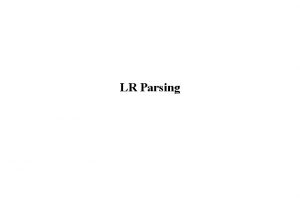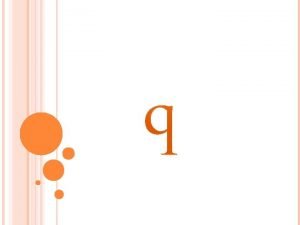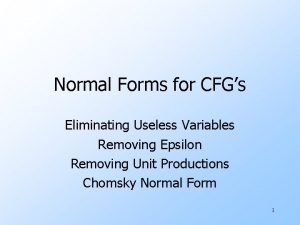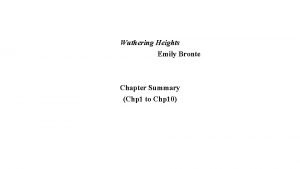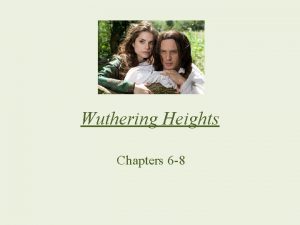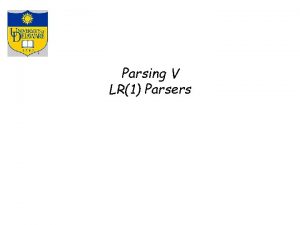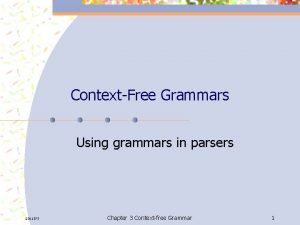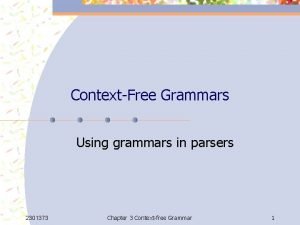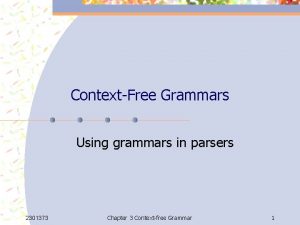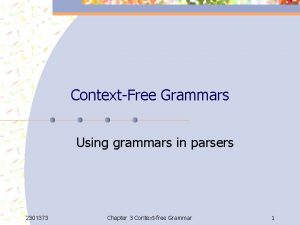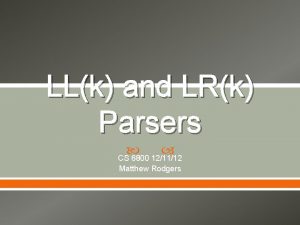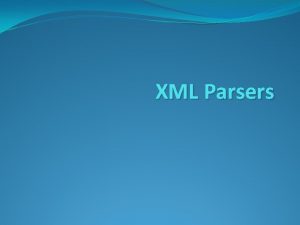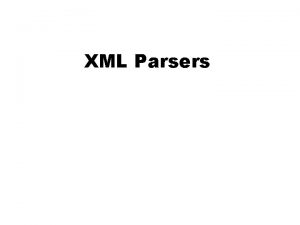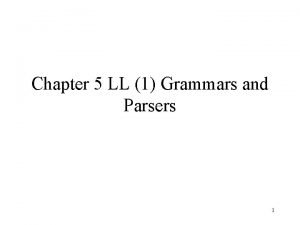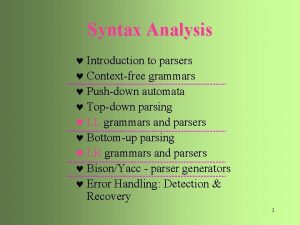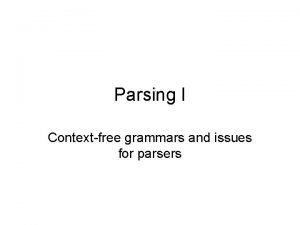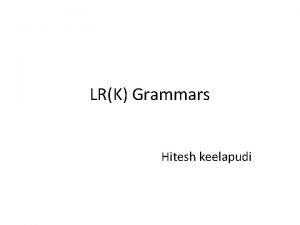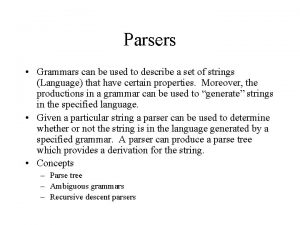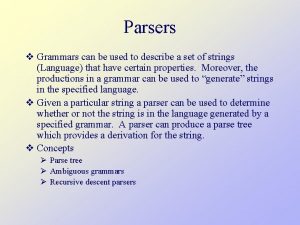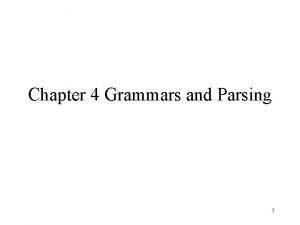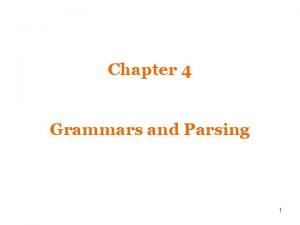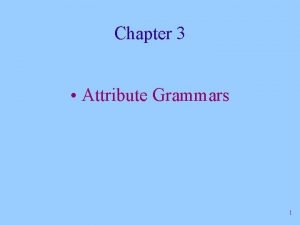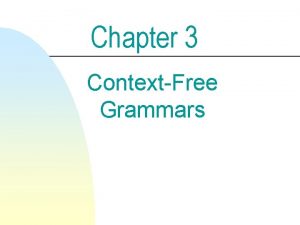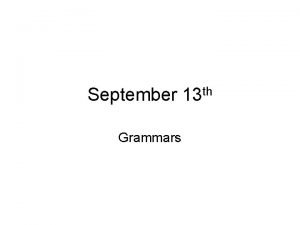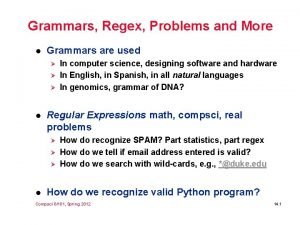Chapter 19 LLk Grammars LLk Parsers n n



























- Slides: 27

Chapter 19 LL(k) Grammars

LL(k) Parsers n n Can be developed using PDAs for parsing CFGs by converting the machines directly into program statements Describe the parsing strategy: i) the input string is scanned in a left-to-right manner ii) the parsers generate a leftmost derivation, and iii) a deterministic top-down parsing using a k-symbol lookahead, attempting to construct a leftmost derivation of an input string Ø The lookahead principle can be used to construct programs that overcome the non-determinism found in some PDA. 2

The Lookahead principle n n n Converting the non-deterministic transitions into the deterministic program segments Predicts which one of the several production rules (in an unambiguous CFG) should be used to process the remaining input symbols Example. Consider a derivation of the string acbb using G: S a. S | c. A Ø A b. A | c. B | B c. B | a | Comparing the lookahead (input) symbol with the terminal symbol in each of the appropriate production rules permits the deterministic construction of each derivation in G Prefix Generated a ac acbb Lookahead Symbol a c b b Production Rule S a. S S c. A A b. A A Derivation S ac. A acbb. A 3 acbb

Lookahead Strings and Lookahead Sets n n Let p be a terminal string. An intermediate step in a derivation * of p has the form S u. Av, where p = ux. The string x is called a lookahead string for the variable A. The lookahead set of A consists of all lookahead strings for A. Defn. 19. 1. 1. Let G = (V, , P, S) be a CFG and A V i) The lookahead set of the variable A, LA(A), is defined by * * LA(A) = { x | S u. Av ux * } ii) For each rule A w in P, the lookahead set of the rule A w is defined by * * LA(A w) = { x | wv x, where x * S Þ u. Av } Note: LA(A w) LA(A) such that LA(A w) dictates the * derivations Av x, which are initiated with the rule A w 4

Lookahead Strings and Lookahead Sets n Example 19. 1. 4. Grammar Rule G 1: S a. Sc | aabc G 2: S a. A A Sc | abc G 3: S aa. Ac A a. Ac | b # of lookahead symbols to be considered 3: aaa…, aab… 2 (for A): aa…, ab… 1 (for A): a…, b… n Example 19. 1. 2. G 2: S ABCabcd, A a | , B b | , C c | LA(S) = { abcabcd, ababcd, acabcd, bcabcd, aabcd, babcd, cabcd, abcd } LA(A a) = { abcabcd, ababcd, acabcd, aabcd } LA(A ) = { bcabcd, babcd, cabcd, abcd } LA(B b) = { bcabcd, babcd } LA(B ) = { cabcd, abcd } LA(C c) = { cabcd } LA(C ) = { abcd } 5

Lookahead Sets in CFGs n Example 19. 1. 1. Given the following grammar G 1: S Aabd | c. Abcd A a|b| LA(S) = { aabd, babd, cabcd, cbcd } LA(S Aabd) = { aabd, babd, abd } LA(S c. Abcd) = { cabcd, cbcd } Ø Ø /* 1 st symbol: { a, b } */ /* 1 st symbol: { c } */ We can select the appropriate S rule above using the 1 st symbol of the LA strings. LA(A a) = { aabd, abcd } /* 2 nd symbol: { aa, ab }; 3 rd symbol: { aab, abc } */ LA(A b) = { babd, bbcd } /* 2 nd symbol: { ba, bb }; 3 rd symbol: { bab, bbc } */ LA(A ) = { abd, bcd } /* 2 nd symbol: { ab, bc }; 3 rd symbol: { abd, bcd } */ The 3 rd symbol of the LA strings provides sufficient information to discriminate which one of the A rules to use. 6

Lookahead Strings and Lookahead Sets n Example 19. 1. 2. Given the following grammar G 2: S ABCabcd, A a | , B b | , C c| LA(S) = { abcabcd, ababcd, acabcd, bcabcd, aabcd, babcd, cabcd, abcd } Ø No lookahead symbol is required in selecting the only S rule A a A Ø The 4 th lookahead symbol is required in selecting the A rule B b B Ø LA(B b) = { bcabcd, babcd } LA(B ) = { cabcd, abcd } The 1 st lookahead symbol is required in selecting the B rule C c C Ø LA(A a) = { abcabcd, ababcd, acabcd, aabcd } LA(A ) = { bcabcd, babcd, cabcd, abcd } LA(C c) = { cabcd } LA(C ) = { abcd } The 1 st lookahead symbol is required in selecting the C rule 7

FIRST, FOLLOW, and Lookahead Sets n n n The lookahead set LAk(A) contains prefixes of length up to k of strings that can be derived from the variable A (and after) If variable A derives strings of length < k, the remainder of the lookahead strings comes from derivations that follow A in the production rules of the grammar. FIRSTk(A) contains prefixes of length up to k of terminal symbols (directly) derivable from A. FOLLOWk(A) contains prefixes of length up to k of terminal symbols that can follow the strings derivable from A. Defn. 19. 2. 1. Let G be a CFG. For every string u (V )* and k > 0, the set FIRSTk(u) is defined by * FIRSTk(u) = trunck( { x | u x, x * } ) where trunck(X) = { u | u X w/ length(u) k or uv X w/ length(u) = k }8

FIRST, FOLLOW, and Lookahead Sets n Defn. 19. 2. 3. Let G be a CFG. For every A V and k > 0, the set FOLLOWk(A) is defined by FOLLOWk(A) = { x | S n * u. Av and x FIRSTk(v) } Example 19. 2. 1. Given G 2 (in Example 19. 1. 2), S ABCabcd, A a | , B b | , C c| where ABC { abc, ab, ac, bc, a, b, c, } FIRST 1(ABC) = { a, b, c, } FIRST 2(ABC) = { ab, ac, bc, a, b, c, } FIRST 3(S) = { abc, aba, aca, bca, aab, bab, cab } n Example 19. 2. 2. FOLLOW 1(S) = { } FOLLOW 1(A) = { b, c, a } FOLLOW 1(B) = { c, a } FOLLOW 1(C) = { a } FOLLOW 2(S) = { } FOLLOW 2(A) = { bc, ba, ca, ab } FOLLOW 2(B) = { ca, ab } 9 FOLLOW 2(C) = { ab }

FIRST, FOLLOW and Lookahead Sets n Lemma 19. 2. 2. For every k > 0, 1. 2. 3. 4. 5. n FIRSTk( ) = { } FIRSTk(a) = { a } FIRSTk(au) = { av | v FIRSTk-1(u) } FIRSTk(uv) = trunck(FIRSTk(u) FIRSTk(v)) If A w G, then FIRSTk(w) FIRSTk(A) Lemma 19. 2. 4. For every k > 0, 1. FOLLOWk(S) contains , where S is the start symbol of G 2. If A u. B G, then FOLLOWk(A) FOLLOWk(B), i. e. , any string that follows A can also follow B 3. If A u. Bv G, then trunck(FIRSTk(v) FOLLOWk(A)) FOLLOWk(B) i. e. , the strings that follow B include those generated by v concatenated with all terminal strings that follow A n Example: Given S a. Sc | b. Sc | FIRST 1(S) = { a, b, } FIRST 2(S) = { aa, ab, ac, ba, bb, bc, } FOLLOW 1(S) = { c, } FOLLOW 2(S) = { c, cc, } 10

LL(K) Grammars n Theorem 19. 2. 5. Let G be a CFG. For every k > 0, A V, and rule A w = u 1 u 2…un in P, i) LAk(A) = trunck(FIRSTk(A) FOLLOWk(A)) ii) LAk(A w) = trunck(FIRSTk(w) FOLLOWk(A)) = trunck(FIRSTk(u 1)…FIRSTk(un) FOLLOWk(A)) 11

19. 4. Construction of FIRSTk Sets n Algorithm 19. 4. 1 Construction of FIRSTk Sets • Input: a CFG G = (V, , P, S) 1. For each a , do F’(a) : = { a } 2. For each A V, do F(A) : = { } if A P otherwise 3. Repeat 3. 1 for each A V, do F’(A) : = F(A) 3. 2 for each rule A u 1 u 2 …un with n > 0 do F(A) : = F(A) trunck(F’(u 1)F’(u 2) … F’(un)) UNTIL F(A) = F’(A), A V 4. FIRSTk(A) = F(A) 12

19. 4. Construction of FIRSTk Sets n Example 19. 4. 1 Construct the FIRST 2 sets for the variables of S A## A a. Ad | BC B b. Bc | C ac. C | ad F ’(a) = a F ’(b) = b F ’(c) = c F ’(d) = d F ’(#) = # F(S) = F(A) = F(B) = { } F(C) = F(S) : = F(S) trunc 2(F ’(A) { # }) F(A) : = F(A) trunc 2({ a } F ’(A) { d }) trunc 2(F ’(B) F ’(C)) F(B) : = F(B) trunc 2({ b } F ’(B) { c }) F(C) : = F(C) trunc 2({ a } { c } F ’(C)) trunc 2({ a } { d }) F(S) F(A) { ad, bc } 4 { ad, bc } { ad, bc, aa, ab, ac, bb } 5 { ad, bc, aa, ab, ac, bb } 0 1 2 3 F(B) { } F(C) { , bc } { , bc, bb } { ad, ac } {ad, ac } { , bc, bb } { ad, ac } 13

19. 4. Construction of FOLLOWk Sets n Algorithm 19. 5. 1 Construction of FOLLOWk Sets • Input: a CFG G = (V, , P, S), FIRSTk(A) for every A V 1. FL(S) : = { } 2. for each A V – { S } , do FL(A) : = 3. repeat 3. 1 for each A V, do FL’(A) : = FL(A) 3. 2 for each rule A w = u 1 u 2 … un with w * do 3. 2. 1. L : = FL’(A) 3. 2. 2. if un V, then FL(un) : = FL(un) L 3. 2. 3. for i : = n – 1 to 1 do 3. 2. 3. 1. L : = trunck(FIRSTk(ui+1) L) 3. 2. if ui V, then FL(ui) : = FL(ui) L until FL(A) = FL’(A), A V 4. FOLLOWk(A) = FL(A) 14

19. 5. Construction of FOLLOWk Sets n Example 19. 5. 1 Construct the FOLLOW 2 sets for the variables of Assignments Rule S A## A a. Ad A BC * FL(A) : = FL(A) trunc 2({ # } FL’(S)) FL(A) : = FL(A) trunc 2({ d } FL’(A)) FL(C) : = FL(C) FL’(A) FL(B) : = FL(B) trunc 2(FIRST 2(C) FL’(A)) : = FL(B) trunc 2({ ad, ac } FL’(A)) * FL(B) : = FL(B) trunc 2({ c } FL’(B)) B b. Bc C ac. C | ad FL(C) : = FL(C) FL’(C) 0 1 2 3 4 5 FL(S) { } { } { } FL(A) FL(B) FL(C) { ## } { ##, d# } { ad, ac } { ##, dd } { ad, ac, ca } { ##, d#, dd } { ad, ac, ca, cc } { ##, dd } 15

19. 5 Construction of LAk Sets n Example 19. 5. 2 Construct the LA 2 sets for the rules of LA 2(S A##) = { ad, bc, aa, ab, bb, ac } LA 2 (A a. Ad) = { aa, ab } LA 2 (A BC) = { ad, ac, bb } LA 2 (B b. Bc) = { bc, bb } LA 2 (B ) = { ad, ac, ca, cc } LA 2 (C ac. C) = { ac } LA 2 (C ad) = { ad } FIRST 2(S) FIRST 2(B) { ad, bc, aa, ab, bb, ac } { , bc, bb } FOLLOW 2(S) { } FIRST 2(A) FIRST 2(C) { ad, ac } FOLLOW 2(A) FOLLOW 2(B) FOLLOW 2(C) { ##, dd } { ad, ac, ca, cc } { ##, dd } 16

19. 3 Strong LL(K) Grammars n In strong LL(k) grammars Ø Ø A V, LAk(A) is partitioned by LAk(A wi), i 1 An endmarker #k is attached to the end of each string in the grammar to guarantee that every LA string contains exactly k symbols Ø Definition 19. 3. 1 Let G = (V, , P, S) be a CFG w/ endmarker #k. G is strong LL(k) if there are two leftmost derivations * * * S u 1 Av 1 u 1 xv 1 u 1 zw 1 * * * S u 2 Av 2 u 2 yv 2 u 2 zw 2 where ui, wi, z * (i = 1 or 2) and length(z) = k, then x = y. Ø Theorem 19. 3. 2 A grammar G is strong LL(k) if and only if i, LAk(A wi) partition LA(A) for each variable A V. 17

19. 6 A Strong LL(1) Grammar n Given the following grammar G: S A# A TB B Z| Y Z| T b | (A) Z +TY G is a strong LL(1) since the LA 1 sets for the rules are disjoint LA 1(S A#) = { b, ( } LA 1 (A TB) = { b, ( } LA 1 (B Z) = { + } LA 1 (B ) = { #, ) } LA 1 (Z +TY) = { + } LA 1 (Y Z ) = { + } LA 1 (Y ) = { #, ) } LA 1 (T b) = { b } LA 1 (T (A)) = { ( } 18

19. 7 A Strong LL(k) Parser n Example 19. 7. 1 LA 1(S A#) = { b, ( } LA 1 (B Z) = { + } LA 1 (A TB) = { b, ( } LA 1 (B ) = { #, ) } Input String: LA 1 (Y Z ) = { + } LA 1 (T b) = { b } p = (b+b)# LA 1 (Y ) = { #, ) } LA 1 (T (A)) = { ( } LA 1 (Z +TY) = { + } u A S A T ( A ( T (b B (b Z (b+ T (b+b Y (b+b) B V # B# )B# B)B# )B# Y)B# # LA ( ( ( b b + + b ) # Rule S A# A TB T (A) A TB T b B Z Z +TY T b Y B Derivation S A# TB# (A)B# (TB)B# (b. Z)B# (b+TY)B# (b+b)# 19

19. 8 LL(K) Grammars § Definition 19. 8. 1 Let G = (V, , P, S) be a CFG w/ endmarker #k. G is LL(k) if whenever there are two leftmost derivations * * * S u. Av uxv uzw 1 * * * S u. Av uyv uzw 2 where u, wi, z * (i = 1 or 2) and length(z) = k, then x = y. § Theorem 19. 8. 2 Let G = (V, , P, S) be a CFG w/ endmarker #k & u. Av a sentential form of G. 1) The lookahead set of the sentential form u. Av is defined by LAk(u. Av) = FIRSTk(Av). 2) The lookahead set for the sentential form u. Av & rule A w is defined by LAk(u. Av, A w). 20

Lookahead Sets in CFGs n Example 19. 8. 1. Given the LA sets of grammar G 1: LA(S) = { aabd, babd, cabcd, cbcd } LA(S Aabd) = { aabd, babd, abd } LA(S c. Abcd) = { cabcd, cbcd } LA(A a) = { aabd, abcd } /* 1 st symbol: {a, b} */ /* 1 st symbol: { c } */ /* 2 nd symbol: {aa, ab}; 3 rd symbol: {aab, abc} */ LA(A b) = { babd, bbcd } /* 2 nd symbol: {ba, bb}; 3 rd symbol: {bab, bbc} */ LA(A ) = { abd, bcd } /* 2 nd symbol: {ab, bc}; 3 rd symbol: {abd, bcd} */ G 1 is not strong LL(2), but it is strong LL(3) since LA 2(S, S Aabd) = { aa, ba, ab } LA 2(S, S c. Abcd) = { ca, cb } LA 2(c. Abcd, A a) = { ab } LA 2(c. Abcd, A b) = { bb } LA 2(c. Abcd, A ) = { bc } LA 2(Aabd, A a) = { aa } LA 2(Aabd, A b) = { ba } LA 2(Aabd, A ) = { ab } 21

19. 7 A Strong LL(k) Parser n Algorithm 19. 7. 1 Deterministic Parser for a Strong LL(k) Grammar Input: A strong LL(k) grammar G = (V, , P, S), p *, LAk(A w), A w P. Output: p L(G) or p L(G). 1. q : = S 2. repeat 2. 0. Let q = u. Av, where A is the leftmost variable in q. Let p = uyz, where length(y) = k. 2. 1. If y LAk(A w) in P, then q : = uwv. until q = p or y LAk(A w), A rules in P. 3. If q = p, then accept else reject 22

Lookahead Sets in CFGs n Example 19. 8. 2. Given the LA sets of grammar G: S a. BAd | b. Bb. Ad A ab. A | c B ab | a Consider LA 3(B): LA 3(a. BAd, B ab) = { aba, abc } LA 3(a. BAd, B a) = { aab, acd } LA 3(b. Bb. Ad, B ab) = { abb } LA 3(b. Bb. Ad, B a) = { aba, abc } G is not strong LL(k), for any k 1, since LA 3(B ab) = ab(ab)*cd abb(ab)*cd LA 3(B a) = a(ab)*cd ab(ab)*cd 23

19. 8 LL(k) Parser n Algorithm 19. 8. 3 Deterministic Parser for an LL(k) Grammar. Input: An LL(k) grammar G = (V, , P, S), p *, FIRSTk(A), A V Output: p L(G) or p L(G). 1. q : = S 2. Repeat 2. 0. Let q = u. Av, where A is the leftmost variable in q. Let p = uyz, where length(y) = k. 2. 1. For each rule A w, construct LAk(u. Av, A w) 2. 2. If y LAk(u. Av, A w) in P, then q : = uwv. Until q = p or y LAk(u. Av, A w), A rules in P. 3. If q = p, then accept else reject 24

LR(K) Grammars n n n A deterministic bottom-up parser can be adopted in an attempt to reduce the input string to the start symbol of a grammar Read the input string from left to right while constructing a rightmost derivation of the input string using a lookahead system involving k symbols Process (of recognizing input strings of a CFG G): ● Step 1. Transfers symbols from its input to a stack till the uppermost stack symbols match the R. H. S. of some production rule R ● Step 2. Replace these symbols with the L. H. S. of R ● Step 3. Repeat steps 1 and 2 till the top stack symbol is the grammar’s start symbol or halt (i. e. , the input string cannot be derived from G) 25

LR(K) Grammars n Constructing a PDA from a CFG G that behaves as a LR(k) parser: ● Step 1. Create states q 0 (initial), qf (final), q 1 and q 2 ● Step 2. Create transitions (q 0, , ) = { [q 1, #] } and (q 2, , #) = { [qf, ] } ● Step 3. For each terminal symbol x , Create the transition (q 1, x, ) = { [q 1, X] }, where X , a shift ● Step 4. For each production rule N w in P, where w (V )* Create the transition (q 1, , w) = { [q 1, N] }, a reduce ● Step 5. Create the transition (q 1, , S) = { [q 2, ] }, where S is the start symbol in G 26

LR(K) Grammars n Example: Let G be the CFG S z. MNz M a. Ma | z N b. Nb | z A left-to-right, rightmost derivation of the string zazabzbz is: S z. MNz z. Mb. Nbz z. Mbzbz za. Mabzbz zazabzbz 27
 Which of these is also known as look-head lr parser?
Which of these is also known as look-head lr parser? What is unrestricted grammar
What is unrestricted grammar Questions on context free grammar
Questions on context free grammar Which grammar generates regular language
Which grammar generates regular language Eliminating useless symbols
Eliminating useless symbols Type 0 grammar is called unrestricted grammar
Type 0 grammar is called unrestricted grammar The red tent summary
The red tent summary Great gatsby ch 8 summary
Great gatsby ch 8 summary Chapter 10 chemical reactions
Chapter 10 chemical reactions Chapter 11 stoichiometry test answer key
Chapter 11 stoichiometry test answer key Chapter 9 chapter assessment chemical reactions
Chapter 9 chapter assessment chemical reactions Means and extremes of proportions
Means and extremes of proportions Chapter 6 career readiness review
Chapter 6 career readiness review Chapter 7 ionic and metallic bonding chapter answer key
Chapter 7 ionic and metallic bonding chapter answer key Chapter 9 surface water chapter assessment answer key
Chapter 9 surface water chapter assessment answer key Chapter 2 assessment physics
Chapter 2 assessment physics The central science 14th edition
The central science 14th edition Chapter 7 ionic and metallic bonding chapter answer key
Chapter 7 ionic and metallic bonding chapter answer key Chapter test a chapter 4 population ecology answer key
Chapter test a chapter 4 population ecology answer key Chapter 2 standardized test practice answers
Chapter 2 standardized test practice answers Book of philippians background
Book of philippians background Ionic compounds properties
Ionic compounds properties 7 ionic and metallic bonding practice problems
7 ionic and metallic bonding practice problems Tribromine octoxide formula
Tribromine octoxide formula Zeta phi beta kitty meaning
Zeta phi beta kitty meaning Working with young children/answer key chapter 1
Working with young children/answer key chapter 1 Wuthering heights chapter 4 summary
Wuthering heights chapter 4 summary Wuthering heights chapter 6
Wuthering heights chapter 6
